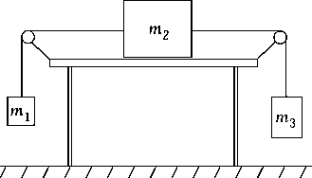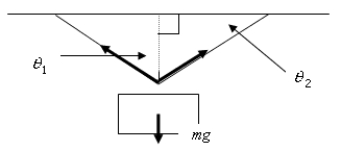A) g · cm
B) g · cm2/s2
C) g · cm/s2
D) g · s/cm
E) cm · s2
Correct Answer

verified
Correct Answer
verified
Multiple Choice
A body moves with constant speed in a straight line. Which of the following statements must be true?
A) No force acts on the body.
B) A single constant force acts on the body in the direction of motion.
C) A single constant force acts on the body in the direction opposite to the motion.
D) A net force of zero acts on the body.
E) A constant net force acts on the body in the direction of motion.
Correct Answer

verified
Correct Answer
verified
Multiple Choice
A ball of mass 2.0 kg is acted on by two forces,  and
and  . At t = 0 s, the particle is at rest at the origin. The position vector at t = 2 s is
. At t = 0 s, the particle is at rest at the origin. The position vector at t = 2 s is
A) ![]()
B) ![]()
C) ![]()
D) ![]()
E) ![]()
Correct Answer

verified
Correct Answer
verified
Multiple Choice
A vertical rope is attached to an object that has a mass of 40.0 kg and is at rest. The tension in the rope needed to give the object an upward speed of 3.50 m/s in 0.700 s is
A) 592 N
B) 390 N
C) 200 N
D) 980 N
E) 720 N
Correct Answer

verified
Correct Answer
verified
Multiple Choice
You want to elope by sliding down a nylon rope made by tying stockings together. The rope will withstand a maximum tension of 300 N without breaking. Your mass is 61.2 kg. The magnitude of the smallest acceleration a with which you can slide down the rope is
A) 9.81 m/s2
B) 4.91 m/s2
C) zero
D) 2.40 m/s2
E) 19.6 m/s2
Correct Answer

verified
Correct Answer
verified
Multiple Choice
A boy holds a bird in his hand. The reaction force to the weight of the bird is the force of the:
A) Earth on the bird.
B) bird on the Earth.
C) hand on the bird.
D) bird on the hand.
E) Earth on the hand.
Correct Answer

verified
Correct Answer
verified
Multiple Choice
An object is moving to the right at a constant speed. Which one of the following statements must be correct?
A) No forces are acting on the object.
B) A larger number of forces are acting on the object to the right than to the left.
C) The net force acting on the object is to the right.
D) No net force is acting on the object.
E) Just one force is acting on the object, and it is acting downward.
Correct Answer

verified
Correct Answer
verified
Multiple Choice
An 80-kg man on ice skates pushes a 40-kg boy, also on skates, with a force of 100 N. The force exerted by the boy on the man is
A) 200 N
B) 100 N
C) 50 N
D) 40 N
E) zero unless the boy pushes back
Correct Answer

verified
Correct Answer
verified
Multiple Choice
A physical quantity that is sometimes described as the measure of the resistance of a body to a change in motion is
A) force
B) mass
C) acceleration
D) weight
E) friction
Correct Answer

verified
Correct Answer
verified
Multiple Choice
If you apply the same force to objects with masses M and 4M, the acceleration of the mass M is
A) the same as for the mass 4M.
B) four times the acceleration of the mass 4M.
C) one-fourth the acceleration of the mass 4M.
D) twice the acceleration of the mass 4M.
E) one-half the acceleration of the mass 4M.
Correct Answer

verified
Correct Answer
verified
Multiple Choice
For this problem, assume no friction. A mass m2 = 3.5 kg rests on a horizontal table and is attached by strings to masses m1 = 1.5 kg and m3 = 2.5 kg as shown. The masses m1 and m3 hang freely. The system is initially held at rest. After it is released, the acceleration of mass m2 will be 
A) zero
B) 1.3 m/s2
C) 5.2 m/s2
D) 8.7 m/s2
E) 9.8 m/s2
Correct Answer

verified
Correct Answer
verified
Multiple Choice
A mass of 25 kg is acted on by two forces:  1 is 15 N due east, and
1 is 15 N due east, and  2 is 10 N due north. The acceleration of the mass is
2 is 10 N due north. The acceleration of the mass is
A) 0.72 m/s2, 56.3º north of east.
B) 0.20 m/s2, due east.
C) 0.72 m/s2, 33.7º north of east.
D) 1.0 m/s2, 33.7º north of east.
E) 0.20 m/s2, 56.3º north of east.
Correct Answer

verified
Correct Answer
verified
Multiple Choice
The acceleration due to gravity on the moon is only about 1/6 of that on Earth. An astronaut whose weight on Earth is 600 N travels to the lunar surface. His mass as measured on the moon is
A) 600 kg
B) 100 kg
C) 61.2 kg
D) 10.0 kg
E) 360 kg
Correct Answer

verified
Correct Answer
verified
Multiple Choice
Two masses m1 = 12 kg and m2 = 35 kg are held connected by a massless rope hung over a frictionless light pulley. If the masses are released then the magnitude of the tension in the string is 
A) 343 N
B) 58.0 N
C) 226 N
D) 458 N
E) 175 N
Correct Answer

verified
Correct Answer
verified
Multiple Choice
According to Newton's law of inertia,
A) objects moving with an initial speed relative to a given frame of reference eventually come to rest relative to the reference frame.
B) whether an object is at rest or is moving with constant velocity depends on the inertial reference frame in which the object is observed.
C) rest is the most natural state of motion.
D) an object at rest in a given frame of reference eventually finds itself in motion relative to the frame of reference.
E) forces always exist in pairs.
Correct Answer

verified
Correct Answer
verified
Multiple Choice
When Newton's first law of motion is mentioned, you should immediately think of
A) ![]()
B) action-and-reaction forces.
C) inertia.
D) gravitational forces.
E) centripetal acceleration.
Correct Answer

verified
Correct Answer
verified
Multiple Choice
We all know it makes sense to bend one's knees when dropping from a height. Suppose a very silly 70-kg person were instead to drop down from a height of 1.4 m onto the ground and stop stiffly within a distance of only 0.60 cm. Calculate how many times his own weight is the average force his body feels.
A) 15
B) 24
C) 2.3 103
D) 6.1 102
E) 2.3 102
Correct Answer

verified
Correct Answer
verified
Multiple Choice
A force F produces an acceleration a on an object of mass m. A force 3F is exerted on a second object, and an acceleration 8a results. What is the mass of the second object?
A) 3m
B) 9m
C) 24m
D) (3/8) m
E) (8/3) m
Correct Answer

verified
Correct Answer
verified
Multiple Choice
 Three blocks are connected by massless cords and rest on a frictionless horizontal surface. The blocks are pulled to the right. Mass m1 = 2 m2 = 3 m3, with m1 on the left and m3 on the right. If the pulling force is equal to 90 N, then the tension in the cord between m1 and m2 is
Three blocks are connected by massless cords and rest on a frictionless horizontal surface. The blocks are pulled to the right. Mass m1 = 2 m2 = 3 m3, with m1 on the left and m3 on the right. If the pulling force is equal to 90 N, then the tension in the cord between m1 and m2 is
A) 49 N
B) 15 N
C) 100 N
D) 44 N
E) 85 N
Correct Answer

verified
Correct Answer
verified
Multiple Choice
 The tension in the left-hand string in terms of 1, 2, and m is
The tension in the left-hand string in terms of 1, 2, and m is
A) mg cos 1 / (sin 1 sin 2 + cos 1 cos 2 )
B) mg sin 2 / (sin 1 sin 2 + cos 1 cos 2 )
C) mg cos 2 / (sin 1 sin 2 + cos 1 cos 2 )
D) mg cos 2 / (sin 1 cos 2 + cos 1 sin 2 )
Correct Answer

verified
Correct Answer
verified
Showing 61 - 80 of 117
Related Exams